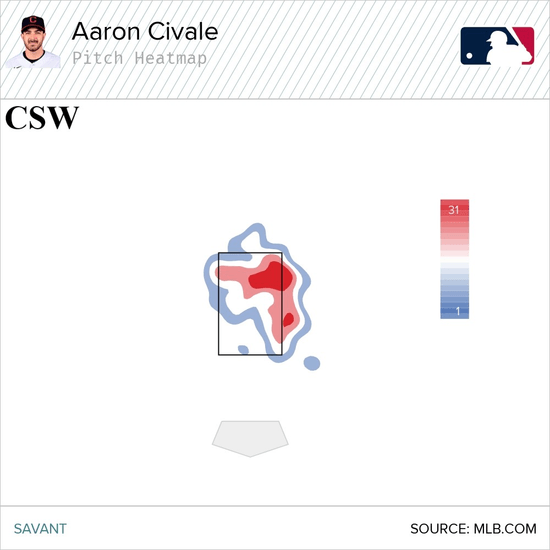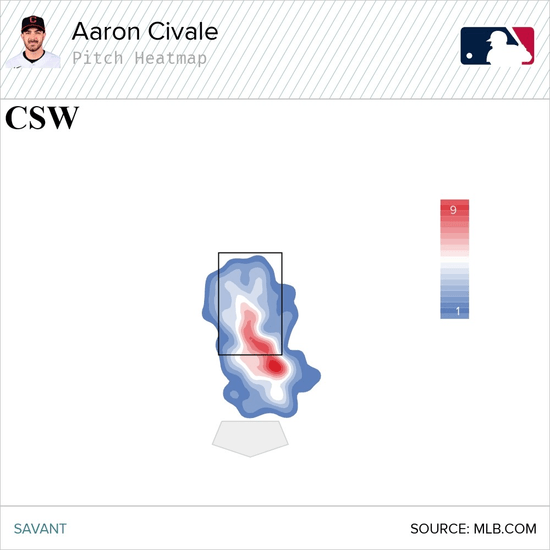Going into 2020, Cleveland was fortunate to have a rotation that was headlined by Shane Bieber and Mike Clevinger, followed closely by Carlos Carrasco. After that, their rotation was much more uncertain. Never mind that ZiPS projected the latter two options for just 2.8 WAR, but it also turned out that Clevinger wouldn’t end up spending much time with the team. Those latter two options? Aaron Civale and Zach Plesac. Plesac currently projects as the better of the two — at least according to ZiPS — and I like him plenty, but I’m not convinced that Civale is the lesser of the two. In fact, there’s a chance that he’s the superior option.
If you’ll remember, Civale started off 2020 like an absolute madman:
I feel like y'all show be freaking out right now.
We've been tossing around the idea of a pitcher going 100% secondary pitches when they have a poor fastball – heaters have the worst wOBA, after all.
Aaron Civale is doing that right now. And he's killing it.
(He threw one SI) pic.twitter.com/tK43vlhQJT
— Nick Pollack (@PitcherList) July 28, 2020
As I noted in response to this tweet, Civale was taking a fascinating approach to start the season. Sinkers are extremely contactable pitches — they’re built to be contacted, after all. Given that he sits about 92 mph with his sinker and 88 mph with his cutter, I wondered how much he could throw his softer stuff and stay away from his sinker and four-seamer. There are starting pitchers that feature their cutters as their main offering — Yu Darvish is a key example — and so I figured a cutter would be a good way to get away from the sinker, velocity be damned.
Civale’s sinker hardly misses any bats. On one hand, Civale’s sinkers ranked in the 23rd percentile in swinging-strike percentage of 57 starting pitchers last year. On the other hand, he got so many called strikes that his 34% sinker CSW ranks in the 86th percentile. As far as sinkers go, he throws a decent one — he has a .314 xwOBA on his sinker since 2019, while the league-average for sinkers is .370. While that seems plenty encouraging, a sinker that hovers around the league-average for xwOBA isn’t a pitch that’s going to set Civale apart, and even worse, I think that .314 figure will negatively regress over time.
For full transparency, Civale’s cutter also has just a .314 xwOBA since 2019. The difference, though, is that I’m not sure there’s much Civale can do to tweak how he’s using his sinker, while I think he can make some changes with his cutter. A cutter as his main fastball? Now that’s intriguing. We’ll visit this first!
Here’s a gif, showing Civale’s cutter location and CSW, since 2019:

Civale emphasizes his cutter to his glove-side on the edge of the plate, but you’ll see that the bulk of his strikes come when he’s elevating his cutter — especially to his glove-side. Oftentimes, it’s not purposeful. There are many times when Civale is trying to locate down in the zone or off the plate to his glove-side and he lets them away from him at the top of the zone. Perhaps he should lean into this some.
Here’s an elevated cutter to Byron Buxton:
https://gfycat.com/lastingfrayedbuck
And another one to Willi Castro:
https://gfycat.com/imaginarywindybedbug
He doesn’t hit his spot either time, but he gets a whiff regardless. It’s not that I think he should throw elevated cutters every time he tosses one in, but if he’s getting called strikes and whiffs alike upstairs — as well as avoiding hitter-friendly contact — then I’m not sure what the downside is. In the manner that Civale is currently using his cutter, it’s returning a 28.5% CSW. For a cutter, that’s quite good, but there’s plenty of room for growth.
Taking into consideration Civale’s cutter’s CSW pitch plot above, I created a search query into Baseball Savant and limited his sample of cutters to the number 12, 13, and 16 attack zones:

By throwing only to these zones, Civale could feasibly raise his cutter’s CSW from 28.6% to 36.2% — at least according to how it’s performed throwing to them over the past two years. It doesn’t get hit especially hard in these zones, either. On batted balls, his cutter surrenders just a .260 xwOBAcon, and has flashed a .251 xwOBA on the whole. Of course, not all of his pitches would end up in these zones, even if that was his intention, but this provides support for the notion that Civale could have two plus pitches in his cutter and curveball. And, as is, they’re currently only his second- and third-most used pitches.
I just spent a lot of time talking about Civale’s cutter, because I think it’s a pitch that he should throw more in place of a more uninspiring sinker. The sinker still has plenty of utility as a pitch to use in his repertoire, but it should certainly be faded somewhat in favor of his best pitches. Now, I’d like to see him sell out in terms of a pitch mix change, but I don’t mean predominantly throwing cutters. I think Civale should go full Adam Wainwright. That is, take his curveball, and throw it a ton more.
The sheer amount of drop Civale gets on his curveball is nearly unparalleled for starters. According to Alex Chamberlain’s pitch leaderboard, only four pitchers get more vertical movement on their curveballs: Trevor Bauer, Tyler Glasnow, Max Fried, and Ross Stripling. Fantastic company! By vertical approach angle (i.e., the angle of the pitch as it crosses home plate), Civale’s curveball is also one of the steepest pitches in baseball. Again, few pitchers best him here: Kyle Hendrick, Clayton Kershaw, Adam Wainwright, Fried (again!), and Hyun-Jin Ryu. Civale bumped up its usage from 11.0% to 21.2% in 2020, and yet it’s still perhaps one of the most underutilized pitches in baseball.
If he wishes to do so, there’s no reason why Civale can’t throw his curveball 38% of the time (as Wainwright does). Of course, there reaches a point of diminishing returns, but I would be willing to bet that he could throw it upwards of 35% without too many ill effects. As with his cutter, we’ll consider his curveball location and curveball CSW, by heat maps:

By pitch location, Civale is already using his curveball about as optimally as possible. His pitch plots are far more alike than not — there’s no tweak required here. The only thing left for him to do is throw it more. Right now, Civale ranks in the 57th percentile in terms of the percentage of pitches that are of the breaking variety. Out of Civale’s rotation mates, Triston McKenzie, Plesac, and Bieber rank in the 72nd, 75th, and 78th percentiles in breaking ball percentage, respectively. While I think it would be judicious to shift that way, he doesn’t necessarily need to.
Consider a tweet of mine from the other day:
five starters had at least four pitches with a 30% CSW or higher:
– shane bieber
– aaron civale
– yu darvish
– sonny gray
– frankie montas— manny snackquiao 🇵🇭 (@_kuyamikey) January 2, 2021
Now, to be fair, this tweet is somewhat misleading. I pulled the data from Chamberlain’s pitch leaderboard, and after speaking with him, it seems like there are some pitch classification issues. In this case, Civale’s sinker is being classified as a four-seam fastball more than it should, so he probably classifies as someone with three pitches with a 30% CSW or higher, rather than four. That’s still plenty impressive, but Bieber’s presence on this list might mean Civale could (and should) go breaking ball-heavy. Bieber added a cutter and still threw heavily leaned on his curveball and slider. Civale could do something similar, given their repertoires aren’t dissimilar.
Here’s an elevated cutter and a buried curveball, overlayed, courtesy of Alex Fast:
https://gfycat.com/friendlycelebratedblackrhino
This feels borderline unfair, and this is just one of his pitch pairings. If he pitches optimally as noted above, he should be able to flip curveballs in and below the zone for strikes, as well as getting called strikes and whiffs at the top of the zone or to his glove-side with his cutter. He’s still got his slider and changeup, his four-seam fastball that he throws above the zone, and his sinker that separates quite a bit from his cutter. In my eyes, the cutter-curveball combo should be the foundation for Civale, save for him reshaping a pitch or adding a new one to his repertoire.
An uptick in curveball usage alone should mean fewer balls in play overall, and more strikes. That’ll lead to more opportunities for strikeouts! It’s simple: take your best pitches and throw them more, and take your lesser pitches and throw them, well, less. There are plenty of precedents for doing this, with many recent examples being quite prominent. A year ago, I wrote two articles saying that Dylan Bundy and Joe Musgrove should make some pitch mix changes, and we all saw how that turned out. Aaron Civale has always had it in him. It’s all a matter of tapping into it.
Photo by Ric Tapia/Icon Sportswire | Adapted by Justin Paradis (@freshmeatcomm on Twitter)

